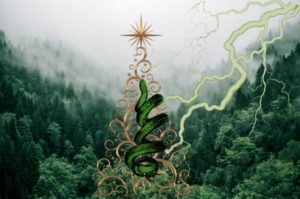
John C. Mannone
The Philadelphia Experiment
When they didn’t come back, we dispatched rescue
teams to find them—swept electromagnetic sensors
to detect temporal shadows. It was difficult to locate
the wreckage with so much lush foliage. But a tall
crooked pine, adorned with coppery leaves, loomed
over a valley glutted with limestone and dry mud.
No sign of pilot or crew, only a plethora of cracked
bones scattered among animal tracks along with deep
clawings into the creek bed, and a slither of scales.
_______________
John C. Mannone has poems in Windhover, North Dakota Quarterly, Poetry South, Baltimore Review, and others. He won the SFPA Dwarf Stars Award (2020); was awarded an HWA Scholarship (2017), a Jean Ritchie Fellowship (2017) in Appalachian literature; and served as celebrity judge for the National Federation of State Poetry Societies (2018). His full-length collections are Disabled Monsters (Linnet’s Wings Press, 2015), Flux Lines (Linnet’s Wings Press, 2021), Sacred Flute (Iris Press, 2022), and Song of the Mountains (Middle Creek Publishing, 2023). He edits poetry for Abyss & Apex and other journals. He’s an Assistant Professor of Physics & Chemistry at Alice Lloyd College in Kentucky.
http://jcmannone.wordpress.com
https://www.facebook.com/jcmannone/
Backstory: This poem may remain mysterious after a several readings, though a sense of dread might linger. It had a convoluted genesis, with a tangential reference to the Christmas tree in the sense it’s a pine tree, but here it is a fantastical tree in a lush forest [a tall / crooked pine, adorned with coppery leaves], which is apparently monstrous and dangerous [cracked / bones scattered along with deep / clawings]. It can be deduced that it is a shape-shifter [slither of scales] and an allusion to evil—the Tree of Knowledge of Good & Evil in the middle of the garden, which was the snake [nachash in the Hebrew actually means magical enchanter but is translated as serpent because of its coppery belly]. Now I’ll reveal a deeper connection, a contradistinctive one: there’s another tree in the garden, the Tree of Life—a true Christmas tree, a giver of life [a symbolized by a Cedar of Lebanon, not a scrub pine/a crooked pine, which represents a fraud and a giver of death]. Finally, this poem can be taken on the surface as just a dark and sad trip into the past but it can as take the reader into a metaphysical realm with allusions to Genesis 3. Whenever I see a pine tree, I think of Christmas, I think of Christ.
Image Credit: Composite of a coppery pine tree with a dangerous snake and an electrical disturbance [a three from kindpng] with the high mountains of Adjara, Georgia [by Marita Kavelashvili at unsplash] as the backdrop.

